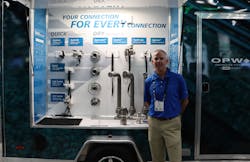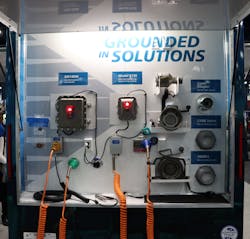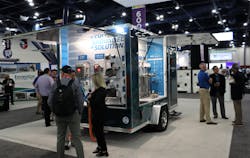HOUSTON—David Morrow, OPW Engineered Systems sales director, has attended more trade shows than he can remember during his 15 years with the Dover company.
And at every one of those stops, everyone wanted to know one thing first: “What’s new?”
This year, it was OPW’s approach.
Instead of unveiling a new product during the International Liquid Terminals Association’s 2021 International Operating Conference and Trade Show in Houston, OPW debuted a new mobile product display, which took center stage at the George R. Brown Convention Center exhibit hall during the three-day event.
OPW’s new “trade show on wheels” is a 10-foot-by-10-foot trailer custom designed by Chicago-area manufacturer Advantage Trailer, which specializes in mobile marketing trailers. Morrow said the original primarily will tour the Gulf Coast region, but the company envisions a fleet of the trade-show trailers deployed across the country.
“Not as many people are able to get out and go to trade shows, so what we’ve done is said, ‘If they can’t go to the trade show, let’s take the trade show to them,’” he said.
Instead of spending several days traveling, sleeping in hotels, and visiting convention booths, prospective customers and distributors can simply open their office doors and find the trailer parked outside, display doors thrown open, with experts who are eager to walk them through each of OPW’s key product offerings over an outdoor lunch.
As Morrow points out, the fully branded trailer has plenty of interior space for a variety of cargo, including food and drink—and the signature swag trade-show attendees are accustomed to collecting.
The idea is one they had kicked around for a while, Morrow said, but the COVID-19 pandemic accelerated their plans, and made the mobile marketing tool more of a necessity, which, of course, is the mother of invention.
The trailer showcases all the ways in which OPW helps customers move bulk fluids.
One side features OPW’s connection options, including “quick,” or open, disconnects, and “dry,” or closed, disconnects. Quick connectors, like the Kamlok cam-and-groove coupler, provide safe, easy-to-use connections but don’t prevent product loss if the line isn’t fully cleared before uncoupling. Dry connectors better contain fluids, and top-of-the-line Epsilon couplings boast the “lowest product loss in the industry.”
“We can walk somebody through all of the different types of connections, and the differences between the connections,” Morrow said.
“You can also operate them, and see how they work.”
The back of the trailer houses OPW’s terminal products, including working overfill protection and grounding equipment, and loading-rack couplers. And the driver side exhibits the company’s loading arms for loading and unloading bulk fluids. “If you’re loading a tank truck or railcar with liquid, you need our stuff,” Morrow said.
Hershey’s uses OPW equipment to move chocolate. And every ounce of Jack Daniels’ whiskey runs through OPW loading arms and Kamvalok dry disconnects, Morrow said.
OPW this year saw an uptick in equipment sales to manufacturers of soaps and sanitizers used to prevent the spread of COVID, and pharmaceutical companies producing COVID-related drugs. Its systems also are utilized in top-loading applications, including transfers of pressurized liquids, asphalt, and molten sulfur, and for bottom-loaded products such as gasoline and diesel, and cryogenic materials.
With its newly mobilized display booth, OPW can deliver a “hands-on product experience” in a convenient way. And by providing a broad overview of its capabilities, the trailer also serves as a starting point for discussions about how the company can customize equipment for myriad needs and applications.
“That’s where the engineering comes in,” Morrow said. “We move every fluid, and they all have a unique set of requirements.
“Some people need valves, some people want to use dry disconnects, some use quick connects, and others just flip open the lid of the railcar, put an arm in, and let it rip. Some people are making a hard connection to a railcar, and some are going to open the lid, but they want to put a plate on it to recover vapors. Sometimes it’s a product that has to be heated, so we’ll make a loading arm that is steam-jacketed or electrically traced (like a heating pad), so we keep the arm hot, and that product is able to flow.”
About the Author
Jason McDaniel
Jason McDaniel, based in the Houston TX area, has more than 20 years of experience as an award-winning journalist. He spent 15 writing and editing for daily newspapers, including the Houston Chronicle, and began covering the commercial vehicle industry in 2018. He was named editor of Bulk Transporter and Refrigerated Transporter magazines in July 2020.




